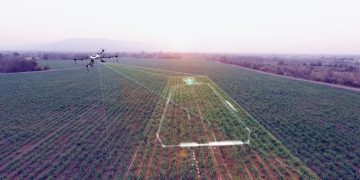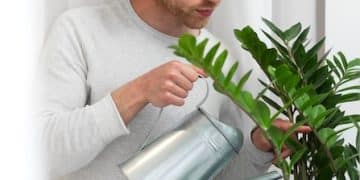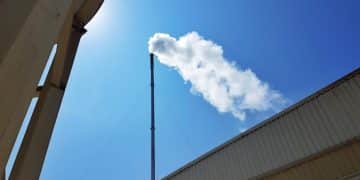US Water Crisis: Practical Solutions to Cut Household Water Use by 15%
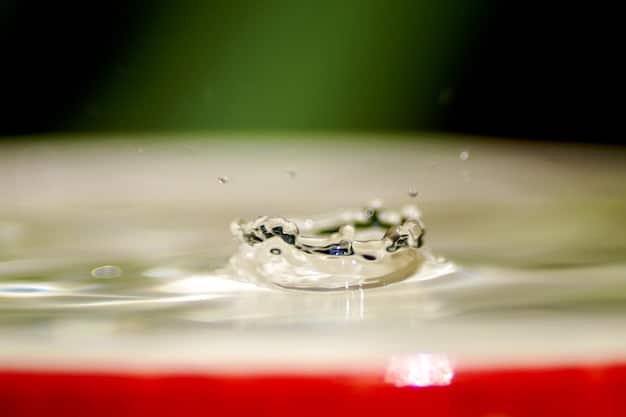
Advertisements
Proactive household water conservation can significantly mitigate the looming US water crisis by implementing practical, everyday solutions that collectively reduce a household’s water footprint by an achievable 15%, contributing to long-term sustainability and resource preservation.
Advertisements
The intensifying US water crisis: practical solutions for conserving water and reducing your household’s footprint by 15% is a growing concern for communities nationwide, impacting everything from agriculture to daily living. Addressing this challenge requires a multi-faceted approach, with individual household contributions playing a pivotal role. This discussion aims to dissect tangible strategies, empowering citizens to actively engage in water conservation efforts and significantly reduce their domestic water consumption, moving towards a more sustainable future.
Advertisements
understanding the US water crisis
The United States, despite its vastness, faces a complex and escalating water crisis. This isn’t merely about drought in arid regions; it’s a systemic issue encompassing depleted aquifers, aging infrastructure, pollution, and increased demand driven by population growth and changing climate patterns. Understanding the multifaceted nature of this crisis is the first step towards effective mitigation. The consequences extend beyond inconvenience, impacting food security, economic stability, and public health.
Historically, water management in the US often operated on the assumption of abundance, leading to unsustainable practices. The Ogallala Aquifer, a vital source of irrigation in the Great Plains, is shrinking at an alarming rate. Rivers like the Colorado, once mighty, now frequently struggle to reach their estuaries due to diversions. This over-extraction is compounded by inefficient water use in various sectors, from agriculture to urban landscapes. Climate change introduces another layer of complexity, altering precipitation patterns, leading to more frequent and intense droughts in some areas, and unpredictable heavy rainfall with subsequent flooding in others, straining existing water management systems.
evolving challenges and regional impacts
The national water crisis manifests differently across regions. The Southwest, long accustomed to aridity, faces extreme water stress, with states like California and Arizona grappling with chronic drought conditions. This has led to drastic measures, including mandatory water restrictions and innovative, albeit expensive, water recycling projects. The Southeast, while generally wetter, experiences periodic droughts that impact agriculture and energy production. The Midwest and Great Plains contend with the depletion of groundwater reserves crucial for farming, while aging infrastructure in older cities nationwide leads to significant water main breaks and loss, further exacerbating scarcity.
- Western States: Severe multi-year droughts, reliance on shrinking snowpacks.
- Midwestern States: Over-reliance on groundwater for agriculture leading to aquifer depletion.
- Southeastern States: Periodic droughts, increasing population density straining resources.
- Northeastern States: Aging infrastructure, combined sewer overflows impacting water quality.
The interconnectedness of water systems means that problems in one region can have ripple effects elsewhere. For example, reduced water flow in the Colorado River due to upstream demands impacts states downstream and Mexico. Furthermore, water quality issues, stemming from agricultural runoff, industrial discharge, and inadequate wastewater treatment, contaminate usable supplies, effectively reducing the available fresh water. Addressing these challenges requires a paradigm shift from reactive crisis management to proactive, integrated water resource planning and conservation at all levels, beginning with the choices made in every home.
assessing your household’s current water usage
Before you can effectively reduce your water footprint, it’s essential to understand where and how your household uses water. Most people are surprised to learn how much water is consumed daily, often without conscious thought. A typical American household uses approximately 300 gallons of water per day. Indoor water use accounts for the largest share, with toilets, showers, and washing machines being the biggest consumers. Outdoor water use, primarily for landscaping, can vary significantly depending on climate and gardening practices, but it often represents a considerable portion of summer water bills.
Reviewing your utility bills is a good starting point. Many water suppliers provide detailed consumption reports that can help identify trends and highlight periods of higher usage. This information can reveal seasonal spikes, likely attributable to outdoor watering, or consistent high usage pointing to inefficient indoor fixtures or habits. Understanding your baseline usage serves as a benchmark against which you can measure the effectiveness of your conservation efforts. This initial assessment transforms the abstract concept of a “water footprint” into concrete numbers unique to your living situation. Consider performing a simple home water audit to pinpoint specific areas of significant consumption.
conducting a simple home water audit
A home water audit doesn’t require specialized equipment; it just needs observation and a little time. Start by checking for leaks, which can silently waste thousands of gallons annually. A running toilet can waste hundreds of gallons a day. You can detect a toilet leak by putting a few drops of food coloring into the tank and waiting 15-20 minutes without flushing; if the color appears in the bowl, you have a leak. Drips from faucets are more obvious but equally wasteful. Quantify these leaks as much as possible.
- Toilets: Account for the largest indoor water use. Check for leaks regularly.
- Showers/Baths: Average showers use 2.5 gallons per minute. Long showers add up.
- Clothes Washers: Older models can use significantly more water than newer, high-efficiency ones.
- Dishwashers: Full loads are always more efficient than partial loads.
- Faucets: Leaks and unnecessarily long running times add to usage.
- Outdoor Usage: Landscaping, car washing contribute heavily in summer months.
Next, observe your daily habits. How long are your showers? Do you leave the faucet running while brushing your teeth or washing dishes? How often do you run your washing machine or dishwasher, and are they always full? For outdoor use, consider how often you water your lawn and plants, and if you’re using efficient irrigation methods. By systematically identifying these habits and inefficient fixtures, you can prioritize which changes will yield the most significant water savings, setting a clear path toward reducing your household’s water footprint by 15% or more.
indoor water saving strategies
Reducing indoor water consumption is one of the most effective ways to lower your household’s water footprint. Small changes in habits combined with smart technological upgrades can lead to substantial savings without compromising comfort or cleanliness. The average American household uses over half of its indoor water in the bathroom for flushing toilets and showering. Therefore, focusing on these areas provides the quickest path to reaching your 15% reduction goal. Every drip and flush counts when you consider the cumulative impact.
Start with simple behavioral adjustments. Turn off the tap while brushing your teeth, shaving, or scrubbing dishes. Shorten your showers by a minute or two. These minor adjustments might seem insignificant individually, but when practiced consistently by everyone in the household, they add up significantly. For instance, just a five-minute shower can use 10 to 25 gallons of water; cutting that by one minute saves 2-5 gallons each time. This mindful approach to water use cultivates a culture of conservation within your home, making it a natural part of daily routines rather than an imposed restriction.
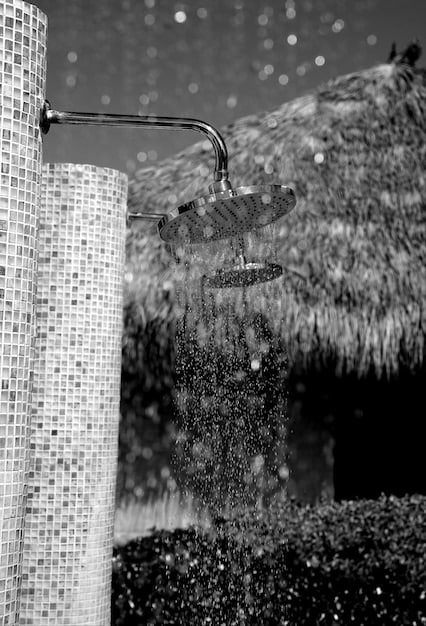
smart fixtures and appliances
Beyond behavioral changes, upgrading to water-efficient fixtures and appliances can drastically reduce consumption. Low-flow showerheads, for example, deliver an invigorating spray while using significantly less water than older models. Look for products labeled with the EPA’s WaterSense certification, which guarantees they are at least 20% more efficient than standard models while meeting performance expectations. Installing aerators on bathroom and kitchen faucets can reduce water flow by up to 50% without noticeable changes in water pressure.
- Toilets: Replace old, standard toilets with high-efficiency (1.28 gallons per flush or less) or dual-flush models.
- Showerheads: Install WaterSense-labeled low-flow showerheads (2.0 gallons per minute or less).
- Faucets: Add aerators to all faucets to reduce flow while maintaining pressure.
- Washing Machines: Upgrade to Energy Star certified front-loading washing machines, which use significantly less water and energy.
- Dishwashers: Choose Energy Star certified dishwashers; they use less water and energy than hand washing when run with full loads.
Even if a full renovation isn’t feasible, replacing a single outdated toilet can save thousands of gallons of water annually. Many local water utilities offer rebates or incentives for purchasing and installing these water-efficient appliances, making the transition more affordable. By combining conscious habits with strategic appliance upgrades, you can achieve and even exceed your 15% reduction target, contributing meaningfully to both your utility bill savings and regional water conservation goals. These practical steps empower individuals to be part of the solution rather than merely observers of the crisis.
outdoor water saving solutions
Outdoor water use, particularly for landscaping, often represents the largest segment of a household’s total water consumption, especially in regions with dry climates or during summer months. Reducing this footprint can yield significant savings, often exceeding the 15% target with thoughtful planning and implementation. The key lies in shifting from traditional, water-intensive landscaping practices to more sustainable, drought-tolerant alternatives that align with local environmental conditions. This not only conserves water but can also reduce maintenance efforts and expenses.
One of the most impactful changes is adopting xeriscaping or native plant landscaping. Xeriscaping is a method of landscaping that uses drought-tolerant plants, efficient irrigation, and mulching to conserve water. Native plants, by their very nature, are adapted to the local climate and soil conditions, requiring less supplemental watering once established compared to non-native species. Replacing thirsty lawns with native grasses, perennial borders, or hardscapes like patios or permeable pavers can dramatically cut water use. For those who enjoy gardening, selecting drought-resistant varieties of flowers, herbs, and vegetables can ensure a thriving garden with minimal water input.
efficient irrigation and greywater systems
Even with water-wise landscaping, efficient irrigation is crucial. Traditional sprinklers often waste water through evaporation, runoff, or by watering non-plant areas. Drip irrigation systems and soaker hoses deliver water directly to the plant roots, minimizing loss and maximizing absorption. Smart irrigation controllers, which use local weather data and soil moisture sensors, can automatically adjust watering schedules, preventing overwatering and ensuring plants receive only what they need. These systems pay for themselves over time through reduced water bills and healthier landscapes.
- Xeriscaping/Native Plants: Choose drought-tolerant or native species suitable for your local climate.
- Smart Irrigation: Install drip irrigation for garden beds and smart controllers for entire systems.
- Mulching: Apply a layer of organic mulch around plants to retain soil moisture and suppress weeds.
- Rainwater Harvesting: Set up a rain barrel to collect rainwater for non-potable outdoor uses.
- Greywater Systems: Explore the potential for using treated laundry or bath water for irrigation in designated areas.
Beyond irrigation, consider rainwater harvesting. Installing a simple rain barrel can capture rainwater from your roof, providing a free, non-potable source for watering plants, washing cars, or cleaning outdoor spaces. For more advanced conservation, greywater recycling systems divert water from sinks, showers, and washing machines for landscape irrigation. While these systems require initial investment and careful planning to comply with local regulations, they offer significant long-term water savings. By combining these smart outdoor solutions, households can make a profound impact on their overall water consumption, paving the way for a more resilient water future.
addressing water quality and conservation
While reducing consumption is paramount, understanding and maintaining water quality also plays a crucial role in overall water resource management and conservation. Contaminated water, even if abundant, is unusable without extensive and costly treatment. Therefore, preventing pollution upstream is as vital as wise use downstream. Households have a direct impact on water quality through the products they use and how they dispose of waste, affecting both local waterways and municipal treatment facilities. The purity of water directly impacts its availability for various uses.
The substances we put down our drains or on our lawns can end up in natural water bodies. Harsh chemical cleaners, pharmaceuticals, and excessive fertilizers or pesticides can contaminate rivers, lakes, and groundwater. Choosing biodegradable cleaning products, properly disposing of medications and hazardous waste (rather than flushing them), and minimizing the use of chemical lawn treatments are all actions that support water quality. Even seemingly minor habits, like allowing oil or paint to go down a storm drain, can have significant cumulative impacts on aquatic ecosystems and public health. Responsible disposal and product choices are fundamental to preserving our water sources.
preventing pollution and promoting stewardship
Beyond avoiding harmful substances, households can actively contribute to water quality through responsible practices. Maintaining septic systems, if applicable, is critical to prevent groundwater contamination. For homes connected to municipal sewers, avoiding flushing non-biodegradable items like wet wipes or grease prevents serious clogs that can lead to sewer overflows, discharging raw sewage into waterways. Participating in community clean-up initiatives for local rivers or beaches also contributes directly to improving water environments. Stewardship extends to educating others and advocating for policies that protect water resources.
- Responsible Disposal: Never flush medications, chemicals, or grease down drains. Dispose of them safely.
- Eco-Friendly Products: Opt for biodegradable and phosphate-free detergents and cleaners.
- Garden Care: Use organic fertilizers and pest control methods, if necessary, to prevent runoff.
- Vehicle Maintenance: Wash cars on porous surfaces (like your lawn) or at commercial car washes that treat their wastewater.
- Stormwater Management: Direct downspouts onto permeable surfaces or rain gardens; avoid impervious surfaces.
Understanding the journey of water from source to tap, and back again, underscores the importance of water quality. Every action taken to prevent pollution helps maintain a cleaner, healthier water supply for everyone, reducing the need for intensive treatment and preserving natural ecosystems. By integrating efforts to conserve water quantity with practices that protect its quality, households solidify their role as responsible environmental stewards, ensuring a safer and more sustainable water future for generations to come. This holistic approach supports the broader goals of addressing the US water crisis.
measuring and maintaining your 15% reduction
Achieving a 15% reduction in your household’s water footprint isn’t a one-time effort; it’s an ongoing commitment that requires consistent monitoring and adaptation. Once you’ve implemented water-saving strategies, the next crucial step is to measure your progress and maintain your new, more efficient habits. Regular review of your water bills is the most straightforward way to track your success. Most utility companies provide graphs or detailed usage reports that allow for easy comparison month-to-month and year-over-year. Celebrate your reductions to reinforce positive behavior.
Keep a simple log of your water meter readings if your utility bill doesn’t offer granular data or if you want to track more frequently. Daily or weekly readings can help identify immediate impacts of new habits or detect hidden leaks quickly. Compare your current usage against your baseline assessment to quantify your achieved reduction. If you’re not seeing the expected 15% decrease, it’s an opportunity to re-evaluate your efforts, identify areas for improvement, or investigate potential inefficiencies you might have overlooked. The goal is to make conservation a permanent part of your household’s operational ethos.
long-term conservation and behavior reinforcement
Maintaining conservation efforts requires consistent reinforcement and adapting to changing needs or seasons. For instance, outdoor watering needs shift dramatically from spring to summer to fall, demanding adjustments to irrigation schedules. Regularly check your water-saving fixtures and appliances to ensure they are functioning optimally. A low-flow showerhead might become clogged over time, affecting its efficiency. Educate all household members, especially children, on the importance of water conservation and engage them in the tracking process; this fosters a collective responsibility.
- Regular Bill Review: Analyze water utility statements for usage trends and reductions.
- Meter Monitoring: Take periodic meter readings to track real-time consumption.
- Leak Detection: Continue routine checks for leaks in toilets, faucets, and outdoor spigots.
- Seasonal Adjustments: Modify watering schedules based on weather and plant needs.
- Household Engagement: Involve family members in conservation goals and celebrate successes.
Beyond individual household efforts, stay informed about local water conservation initiatives and regional water issues. Many communities offer workshops, rebates, or educational materials that can further support your conservation journey. Share your successes and lessons learned with friends and neighbors, inspiring a ripple effect of water-wise practices throughout your community. By diligently measuring, adapting, and reinforcing your water-saving habits, your household can sustain its 15% reduction, contributing significantly to the broader resilience of US water resources and setting an example for others to follow.
the broader impact of household conservation
While individual efforts to reduce a household’s water footprint by 15% might seem small in isolation, their collective impact on the US water crisis is profound. When millions of households adopt these conservation practices, the cumulative effect translates into billions of gallons of saved water annually, significantly alleviating pressure on stressed water supplies. This widespread action complements larger-scale governmental and industrial conservation initiatives, creating a powerful synergistic force for water security across the nation. Every drop saved at home contributes to a larger reservoir of available water for essential uses.
Beyond the direct quantitative savings, widespread household conservation fosters a culture of environmental stewardship and resource awareness. When water becomes a consciously valued resource rather than an endlessly available commodity, it encourages more mindful consumption not just at home, but also influences public opinion and policy. This shift in societal mindset can drive demand for more water-efficient products and services, incentivize utilities to invest further in conservation programs, and support the political will necessary for impactful infrastructure improvements and sustainable water management policies. It’s a fundamental change in how we relate to our most vital resource.
economic, environmental, and social benefits
The benefits of household water conservation extend far beyond simply addressing scarcity. Economically, reduced water use directly translates to lower utility bills for consumers, freeing up household income for other needs. For municipalities, reduced demand can delay or eliminate the need for expensive new water supply projects, saving taxpayer money. Environmentally, less water extraction from rivers and aquifers preserves aquatic ecosystems, supports biodiversity, and helps maintain the natural balance of water cycles. It also reduces the energy required to pump, treat, and transport water, leading to a smaller carbon footprint.
- Economic Savings: Lower monthly water bills for households, reduced infrastructure costs for communities.
- Environmental Health: Preserved ecosystems, healthier rivers and lakes, reduced energy consumption associated with water.
- Community Resilience: Increased water security during droughts, greater adaptability to climate change.
- Social Equity: Ensures more equitable access to water, particularly for vulnerable populations and future generations.
- Innovation Drive: Spurs development of new water-saving technologies and practices.
Socially, a sustainable water future ensures equitable access to clean, safe water for all communities. It reduces water-related conflicts and promotes community cohesion through shared conservation goals. Furthermore, by taking proactive steps, households contribute to building resilience against the unpredictable impacts of climate change, ensuring that future generations inherit a more secure and robust water supply. The simple act of reducing your household’s water footprint by 15% is therefore not just a practical solution to a crisis, but a cornerstone of a more sustainable, prosperous, and equitable society. It exemplifies the power of collective individual action.
| Key Solution | Brief Description |
|---|---|
| 💧 Smart Fixtures | Install low-flow showerheads, efficient toilets, and faucet aerators. |
| 🌳 Water-Wise Landscaping | Adopt xeriscaping or native plants; use drip irrigation. |
| ✔️ Behavioral Changes | Shorten showers, turn off taps, run full loads of laundry/dishes. |
| 🔍 Monitor Usage | Regularly check water bills and meters to track progress and identify leaks. |
frequently asked questions about water conservation
▼
Replacing old, high-gallon-per-flush (GPF) toilets with new WaterSense-certified models (1.28 GPF or less) is often the single most impactful indoor water-saving change. Toilets are typically the largest indoor water consumer, and modern designs significantly reduce water use per flush without compromising performance.
▼
For lawns, consider replacing parts of it with drought-tolerant landscaping or native plants. If keeping a lawn, water deeply and infrequently, during early mornings to minimize evaporation. Use smart irrigation controllers that adjust based on weather, and consider aeration to improve water penetration into the soil.
▼
Rainwater harvesting is legal in most US states and is highly practical for non-potable uses like landscape irrigation. Check local regulations and permits, as they vary. A simple rain barrel can collect hundreds of gallons for garden use, reducing reliance on municipal water and lowering your water bill.
▼
To detect hidden leaks, turn off all water-using appliances and faucets in your home. Check your water meter’s leak indicator (usually a small triangle or dial). If it’s still moving, you likely have a leak. For toilets, add food coloring to the tank; if the color reaches the bowl without flushing, there’s a leak.
▼
Greywater is gently used water from sinks, showers, bathtubs, and washing machines. When treated (often through simple filtration), it can be reused for non-potable purposes like landscape irrigation. This significantly reduces the demand on fresh water sources, especially beneficial in arid regions, but awareness of local regulations is crucial.
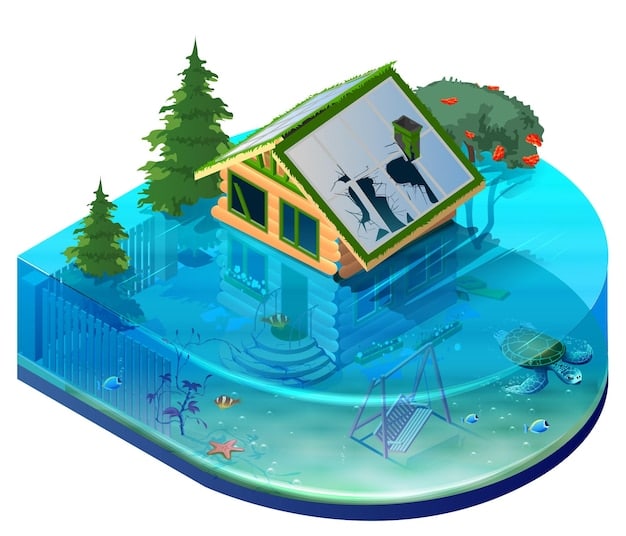
conclusion
The US water crisis is a complex issue demanding immediate and sustained attention, and while large-scale solutions are vital, the cumulative impact of individual household conservation efforts cannot be overstated. By embracing practical strategies, from optimizing indoor fixtures and shifting outdoor landscaping practices to adopting mindful daily habits, every household can significantly reduce its water footprint by 15% or more. This commitment not only contributes to national water security and environmental health but also empowers individuals to be active participants in forging a more sustainable future. The journey towards water resilience begins at home, demonstrating that collective small actions can lead to monumental change.
